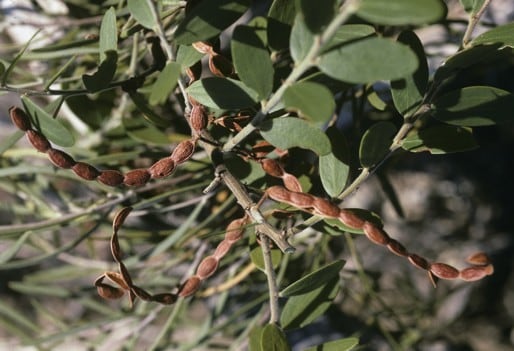Acacia telmica A.R.Chapm. & Maslin
WATTLE
Acacias of Australia
Family
Fabaceae
Distribution
An uncommon species occurring in the Irwin–Strawberry (near Dongara) and Lake Logue–Lake Indoon areas (near Eneabba), south-western W.A.
Description
Dense rounded shrub, 1–3 m high, 1.5–5 m wide. Branchlets densely puberulous. Phyllodes elliptic to narrowly elliptic, (1.5–) 2–4 (–5.5) cm long, (6–) 8–20 mm wide, l:w = 2–4, commonly obtuse, ±thin, dark green or subglaucous, appressed-puberulous on margins and nerves when young, ageing glabrous except sometimes sparsely hairy near base, 1- or 2-nerved, with lateral nerves obscure; glands not prominent, 6–10 (–20) mm above pulvinus, and at base of mucro; pulvinus puberulous. Inflorescences 3–5-headed racemes; raceme axes 10–25 mm long, puberulous, commonly growing out; peduncles 6–10 mm long, sparsely puberulous or sometimes glabrous; heads globular, subdense, 18–25-flowered, golden. Flowers 5-merous; sepals united into a ±truncate calyx. Pods submoniliform, to c. 5 cm long, 4–5 mm wide, crustaceous, breaking readily at constrictions, appressed-puberulous especially at constrictions. Seeds longitudinal, oblong-elliptic, 3.5–4 mm long, slightly shiny, grey-brown; aril usually orange.
Habitat
Grows in sand, loam and loamy clay in low-lying seasonally moist areas, in woodland or shrubland.
Specimens
W.A.: SE of Lake Logue on causeway, 12.5 km W of Brand Hwy on Eneabba–Leeman road, A.R.Chapman 563 (CANB, K, MEL, PERTH); loc. id., A.R.Chapman 563A (PERTH); 7.2 km along Milo Rd S of Dongara–Mullewa road, A.R.Chapman 604 (AD, BM, BRI, CANB, K, MEL, MO, NSW, PERTH).
Notes
Occasional individuals in the Lake Logue population have cream coloured rather than orange arils.
A member of the ‘A. bivenosa group’, geographically close to A. rostellifera and A. xanthina but readily distinguished from both by shorter phyllodes and the presence of an indumentum on the young growth, branchlets, raceme axes, etc. These characters render it superficially similar to the more northerly distributed A. startii. Also related to A. didyma.
FOA Reference
Data derived from Flora of Australia Volumes 11A (2001), 11B (2001) and 12 (1998), products of ABRS, ©Commonwealth of Australia
Author
A.R.Chapman, B.R.Maslin
Minor edits by B.R.Maslin & J.Rogers
This identification key and fact sheets are available as a mobile application:
URL: https://apps.lucidcentral.org/wattle/
© Copyright 2018. All rights reserved.










